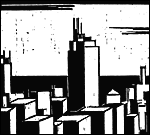Calvin Tomkins, The Scene: Reports on Post-Modern Art (Viking Press, 1976) During the 1970's, Calvin Tomkins covered the tumultuous American art scene for the New Yorker, using the magazine's long-form pages to orbit around a controversial group of artists. His calm prose sliced through the dense theories and critical confusion that greeted most projects during that decade. "An art critic once scolded me for writing uncritically," he confessed in his preface, but that charge falls flat 20 years later. In the middle of an art "crisis," thick with negative publicity, bizarre performances, and uncertain critics, Tomkins engaged with this work rigorously as an academic, but writes with the simple tone of a friendly teacher. "Raggedy Andy," a profile of Andy Warhol, is the cornerstone of the whole book. Tompkins spends half his essay digging through the ambitious artist's early days as an illustrator, tracing Warhol's struggles to make it in New York City. Poring through simple sketches of whimsical cats and shoes that Warhol drew for magazines, Tomkins draws a clear line between these light pieces and his more famous silk-screen paintings of soup cans and celebrities. With every artist, Tompkins steered away from discussions of publicity and notoriety (questions that still haunt Warhol's legacy), finding instead the simplest artistic motivation underneath an over-hyped artistic generation. Tomkins picks out the visionaries that guided individual movements in the 70's, rather than diluting his focus with too many artists. For instance, Tomkins dedicates an essay to Henry Geldzahler, the director of the contemporary art section of the Metropolitan Museum of Art. He noticed Geldzahler's sense of childhood-wonder, tracing it through a career almost overwhelmed by celebrities, drugs, and bewildered art patrons. "If you clung to a fixed position you were bound to miss a lot of what was happening all around you, and Henry didn't want to miss anything. Henry was moving with the flow," Tomkins writes. In the same way, his prose weaved through that decade, following the best artists with a novelistic eye. Tomkins' book has aged well. One essay lingers on the shimmering, gigantic curtains that Christo Javacheff stretched over buildings and spread over canyons. In the 70's, most audiences laughed off this kind of work — but Christo's output has survived much longer than the creations of most artists from his generation. (In 2005, he will cover Central Park with his signature orange fabrics, still part of the cutting-edge of the art world.) Tomkins singles out landscape artists like Smithson and Heizer, at a time when most critics ignored these massive artworks carved into nature. Just a few years ago, MoMA opened a museum upstate dedicated to this kind of environmental art. Similarly, Tomkins spots a few key video and film creators out of a crowded field of artists. In a 1976 review, New York Times art critic Peter Schjeldahl attacked the book as "only incidentally about art," only good for "persuading future generations that Andy Warhol ever really existed." Only two books by Tomkins remain in print today: Bride and the Bachelors: The Heretical Courtship in Modern Art (1976 and Duchcamp: A Biography (1999)— both dedicated to the kind of artist that Schjeldahl rejected. While critics "scolded" Tomkins and his subjects for depending on fads, these artists endured and still influence the "scene" today. Unfortunately, most of Tomkins' work remains out-of-print while these artists sell works for millions of dollars. MORE: Recent Art Catalog Review of a Few of Tomkins' Subjects Tomkins' cited in Bartleby's A better bibliography, with short reviews |
 |
|||||||||||||||||||||||||||